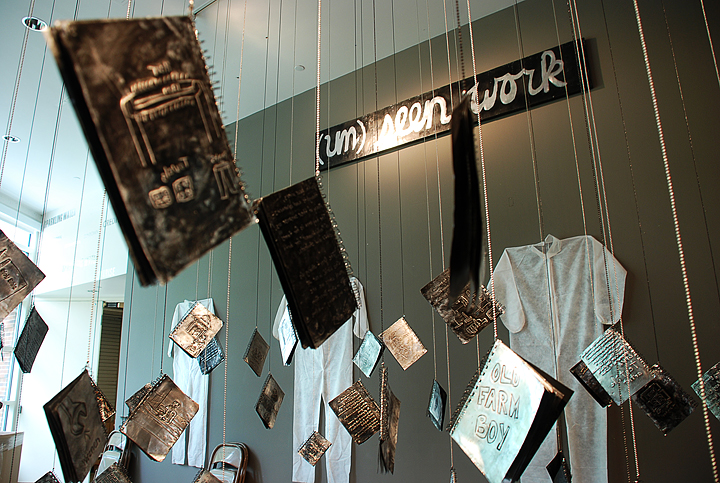Some might think of Grinnell as a small, isolated town where little happens, but Faulconer Gallery’s newest exhibition is here to challenge that idea.
“Culturing Community: Projects about Place” encourages visitors to rethink their notions of Grinnell and other small towns. Curated by Lesley Wright, the director of Faulconer Gallery, the exhibit features four different projects, each of which examines the town of Grinnell from a different perspective. Specifically, the projects push viewers to see the human side of small-town America and feature intimate stories of people who work in towns, the objects that they value and how they use the space around them. As a collection, the exhibit intimately explores the concept of small-town community—the people within it and its role within the wider world.

Upon entering the gallery, a sculpture crafted by the world’s largest artist collective, “The Moving Crew,” is most prominent. The piece consists of about 1,700 brightly-colored cardboard boxes custom-made to match the dimensions of a full-scale shipping container—8 by 8½ by 20 feet. Shipping containers that run through Grinnell typically carry plastic and electronic goods produced in China and South East Asia—this piece romanticizes the international connection.
“[The boxes were] wonderfully mysterious evocations of globalism that are right in a tiny town in the middle of Iowa,” Wright said.
By its sheer size, the sculpture dominates the gallery—an ironic statement, perhaps, since many rarely consider how Grinnell is connected to the outside world through the shipping containers that pass through the town via rail so often. The fact that artists from around the world submitted designs for the boxes underscores the international theme. Although the boxes are made of cardboard, they look authentic with their logos, graffiti and painted rust.
Slightly behind the sculpture lies a collection of Stephen Longmire’s photo essay, entitled “Life and Death on the Prairie.” It portrays the conflict over the use of the Rochester Cemetery in Iowa as both a resting place and a prairie land. The project is arranged separately from the others, and perhaps appropriately so, as the photos deal with the issue of how space and locations are used.
“This is a story about the coexistence of people and place, a gentle tug of war for self-definition. Which will prevail?” Longmire said in an e-mail.
Certainly the project conveys a certain mood of tension—it is made of photographs of a cemetery, after all.
The next piece in the exhibit’s progression is a work by artist Jane Gilmor, entitled “(Un)Seen Work: Transitions and Traditions.” This project recognizes and dignifies the lives of workers whose contribution is generally ignored—cleaners, factory workers, truck drivers.
“It is true that we have probably close to a fifth of our population … below the poverty level here, and we tend to ignore that. … I wanted to acknowledge that in the show to a certain degree … that there are people here who do important work that is not as validated [as other professions], yet they all make up this community,” Wright said.
Made mostly out of aluminum, the piece adopts a rugged, hands-on approach. Short aluminum books are written by the workers—“My Job as a Mechanical Engineer,” “Old Farm Boy,” “Kellogg’s Rice Crispies.” Visitors will certainly be moved by the poignancy of the workers’ stories.
“One of my first jobs was to deliver milk with my red wagon. It was my job every late afternoon. It was the highlight of my day to deliver these bottles and chat with customers, who often invited me in and gave me candy. This was depression times, so I didn’t get paid, but I could take all the milk I wanted,” wrote one contributor.
“I think this project brought many parts of the Grinnell community closer together and gave a voice to those who often don’t have one in a smaller town. I hope it gave them a sense of empowerment with in the community and a sense of the importance of their contributions … I learned Grinnellians are really nice people!” wrote Gilmor via e-mail.
The last of the four projects is entitled “Collective: The Grinnell People’s Museum.” The piece is installed in three locations—the Faulconer Gallery, the Drake Library and the Joe Rosenfield ’25 Center. It is composed of scanned photographs and stories of meaningful objects that tie people to Grinnell.
“We are intrigued by material culture, the objects we make and collect, and how these reflect who we are, where we are from, and what is important to us. … We included images from personal as well as College collections, because both tell us about Grinnell in different ways. The stories are funny, intriguing, serious, important and poignant. Some are memorials, others remind us of an event, some are important for research and a few are just silly,” wrote Marguerite Perret, one of the contributing artists, in an e-mail.
Wright highlighted the importance of community in the exhibition, inviting both students and the larger Grinnell population to visit Faulconer Gallery.
“As a small city in Iowa, Grinnell is one of only a handful of cities our size that’s really vital and surviving and actually thriving. … The presence of the College can’t be denied as a vital part of that. … It’s important to me that both Grinnell College and Grinnell community value one another. … I hope Grinnell College students realize that things are going on in the community and that there [are a lot of issues and events] that are out there that they may not understand and notice. But if you dig a little bit, you’re going see a lot [more],” Wright said.
“Culturing Community: Projects about Place” opens today at 5 p.m. and will run until Dec. 12.




























































